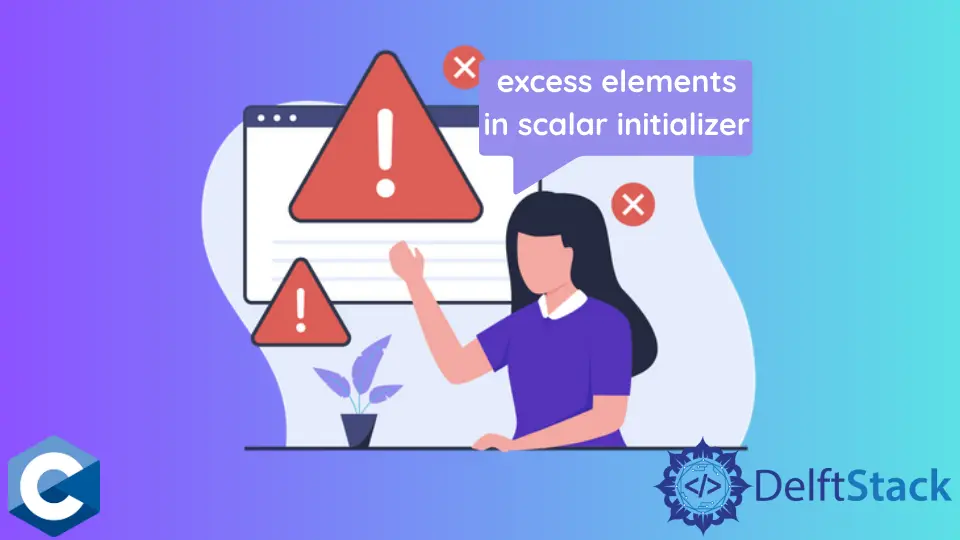Exceso de elementos en advertencia de inicializador escalar en C

Al trabajar con C, es posible que te encuentres con un mensaje de advertencia que dice "excess elements in scalar initializer.". Esta advertencia aparece cuando inicializamos el array con demasiados elementos.
En esta guía, profundizaremos en los detalles de esta advertencia y cómo resolverla.
Solucionar el mensaje de advertencia excess elements in scalar initializer en C
Código de ejemplo 1:
#include <stdio.h>
int main(void) {
int array[2][3][4] = {
{{11, 22, 33}, {44, 55, 66}, {0, 0, 0}},
{{161, 102, 13}, {104, 15, 16}, {107, 18, 19}},
{{100, 20, 30, 400}, {500, 60, 70, 80}, {960, 100, 110, 120}}};
// Your code here
return 0;
}
Salida:
In function 'main':
[Warning] excess elements in array initializer
[Warning] (near initialization for 'array')
El error anterior ocurre porque se declara como int[2][3][4], pero estamos intentando inicializarlo como si fuera un int[3][3][4].
Para resolver este error, debemos corregir el tamaño del array.
Código corregido (Ejemplo 1):
#include <stdio.h>
int main(void) {
int array[3][3][4] = {
{{11, 22, 33}, {44, 55, 66}, {0, 0, 0, 0}},
{{161, 102, 13}, {104, 15, 16}, {107, 18, 19, 0}},
{{100, 20, 30, 400}, {500, 60, 70, 80}, {960, 100, 110, 120}}};
// Your code here
return 0;
}
Veamos otro ejemplo.
Código de ejemplo 2:
#include <stdio.h>
int main(void) {
static char(*check)[13] = {
{1, 2, 3, 4, 5, 6, 7, 8, 9, 10, 11, 12, 13},
{11, 22, 33, 44, 55, 66, 77, 88, 99, 100, 110, 120, 130}};
// Your code here
return 0;
}
También obtenemos la misma advertencia; el compilador da la advertencia porque hemos pasado dos punteros, pero solo existe un solo puntero a un array de 13 elementos. Hay más elementos de los necesarios declarados.
Podemos resolver esto de dos formas.
Código corregido 1 (Ejemplo 2):
#include <stdio.h>
int main(void) {
// Define two character arrays
char ar1[] = {1, 2, 3, 4, 5, 6, 7, 8, 9, 10, 11, 12, 13};
char ar2[] = {11, 22, 33, 44, 55, 66, 77, 88, 99, 100, 110, 120, 130};
// Create an array of character pointers and initialize it with the addresses
// of ar1 and ar2
char *check[] = {ar1, ar2};
// Print the elements in ar1
printf("ar1: ");
for (int i = 0; i < sizeof(ar1) / sizeof(ar1[0]); i++) {
printf("%d ", ar1[i]);
}
printf("\n");
// Print the elements in ar2
printf("ar2: ");
for (int i = 0; i < sizeof(ar2) / sizeof(ar2[0]); i++) {
printf("%d ", ar2[i]);
}
printf("\n");
// Print the elements using the check array of pointers
printf("check[0]: ");
for (int i = 0; i < sizeof(ar1) / sizeof(ar1[0]); i++) {
printf("%d ", check[0][i]);
}
printf("\n");
printf("check[1]: ");
for (int i = 0; i < sizeof(ar2) / sizeof(ar2[0]); i++) {
printf("%d ", check[1][i]);
}
printf("\n");
return 0;
}
Salida:
ar1: 1 2 3 4 5 6 7 8 9 10 11 12 13
ar2: 11 22 33 44 55 66 77 88 99 100 110 120 130
check[0]: 1 2 3 4 5 6 7 8 9 10 11 12 13
check[1]: 11 22 33 44 55 66 77 88 99 100 110 120 130
Código corregido 2 (Ejemplo 2): Solo tenemos un puntero a un array. El puntero apunta a un array de 10 elementos. Podemos incrementar el puntero al array para tomar los siguientes 10 elementos.
#include <stdio.h>
int main(void) {
char(*check)[10] = (char[][10]){{1, 2, 3, 4, 5, 6, 7, 8, 9, 10},
{0, 31, 29, 31, 30, 31, 30, 31, 31, 30}};
// Print the elements in the first sub-array
printf("check[0]: ");
for (int i = 0; i < 10; i++) {
printf("%d ", check[0][i]);
}
printf("\n");
// Print the elements in the second sub-array
printf("check[1]: ");
for (int i = 0; i < 10; i++) {
printf("%d ", check[1][i]);
}
printf("\n");
return 0;
}
Salida:
check[0]: 1 2 3 4 5 6 7 8 9 10
check[1]: 0 31 29 31 30 31 30 31 31 30
